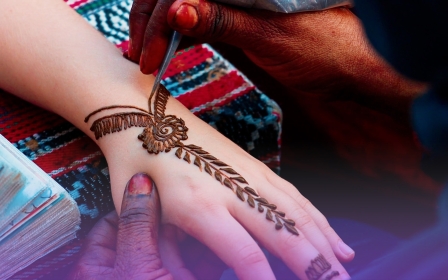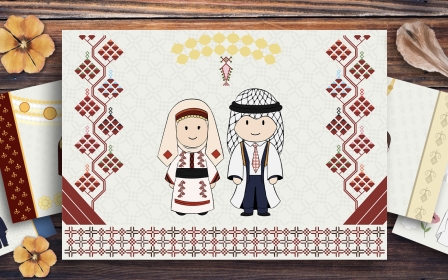Qatar World Cup: Fans adorned in Henna tattoos and immersed in Qatari culture
As thousands of people from around the world descended on Qatar for the World Cup, which is being held in the Middle East for the first time ever, many have been eager to immerse themselves in local culture. Henna art has caught the attention of tourists, some of whom are seeing it for the first time. (All photos by Rakan Abd el Rahman)
Maha El-Naeif, a henna artist based in the historic Souq Waqif, says that she has had people come to visit her stall from different parts of the world. “People of different nationalities come to me, Kuwaitis, Bahrainis, Omanis, Egyptians, Palestinians, Jordanians,” she told Middle East Eye. “Each of them chooses their favourite design, even foreigners know how to choose,” she added. According to El-Naeif, her art has intrigued many passers-by, who often come and ask her what she’s doing.
El-Naeif has been a henna artist for 15 years, eight of which she has spent in Doha’s Souq Waqif. “Drawing has been my hobby since childhood, and has become a source of income for me,” she says. With the income that she makes from decorating people's hands, arms, and feet, she says she has been able to contribute towards raising her children and helping out with her family’s expenses, allowing her to be financially comfortable.
With a table laid out in front of her and a catalogue of designs to choose from, fans head to her stall in between matches, excited to choose a pattern and let the rich colour develop. Henna art is much-loved by many women in the Middle East as it is not permanent and wears off after one to two weeks, which allows people to experiment with designs. Traditionally, many women will have henna designs done for special occasions, such as weddings, Eid, or other celebrations.
“Henna is derived from the famous henna trees in Yemen, Sudan, and India, these are the areas where henna is most abundant and where the best types are found,” El-Naeif explains.
In order to be able to produce intricate patterns, the person drawing the henna design needs to have a steady hand and be very patient. This takes a lot of skill, which can take years to develop. El-Naeif mixes the henna with hot water, some sugar, and suratian oil, which she then puts into bags. According to El-Naeif, not anyone can perform henna, as you need to carefully squeeze the product out of the plastic cone. Too much, and the design can get easily spoilt. “If you don’t know how to hold it properly, you won’t be able to draw,” she says.
Over time, El-Naeif says that she has learned to become very patient as she encounters people from different backgrounds and perspectives. When someone doesn’t like the design, pattern, or colour, she calmly talks through it with them until they reach an agreement, ensuring that everyone leaves having had a pleasant experience.
Middle East Eye propose une couverture et une analyse indépendantes et incomparables du Moyen-Orient, de l’Afrique du Nord et d’autres régions du monde. Pour en savoir plus sur la reprise de ce contenu et les frais qui s’appliquent, veuillez remplir ce formulaire [en anglais]. Pour en savoir plus sur MEE, cliquez ici [en anglais].




